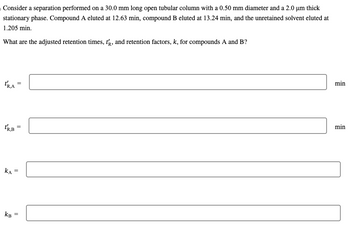
Chemistry
10th Edition
ISBN: 9781305957404
Author: Steven S. Zumdahl, Susan A. Zumdahl, Donald J. DeCoste
Publisher: Cengage Learning
expand_more
expand_more
format_list_bulleted
Question

Transcribed Image Text:Consider a separation performed on a 30.0 mm long open tubular column with a 0.50 mm diameter and a 2.0 µm thick
stationary phase. Compound A eluted at 12.63 min, compound B eluted at 13.24 min, and the unretained solvent eluted at
1.205 min.
What are the adjusted retention times, t, and retention factors, k, for compounds A and B?
TRA
KA
=
||
TRB =
KB
=
=
min
min
Expert Solution
This question has been solved!
Explore an expertly crafted, step-by-step solution for a thorough understanding of key concepts.
Step by stepSolved in 4 steps with 7 images

Knowledge Booster
Learn more about
Need a deep-dive on the concept behind this application? Look no further. Learn more about this topic, chemistry and related others by exploring similar questions and additional content below.Similar questions
- The write-up says “A C18-silica column is used in this experiment, a 0.46 x 15 cm column with 5-µm particles. Equilibrate the column with 20 empty column volumes of 0.010 M phosphate buffer (pH 7.2) at a flow rate of 1.2 mL/min before beginning chromatography.” Show the calculation for how much mobile phase you would use (volume) and how long it will take to equilibrate the column.arrow_forwardThe figure below shows a typical separation of several fat-soluble vitamins by HPLC. The x-axis is retention time in minutes. From the graph try to estimate retention times for peaks 2 and 3. Retention time peak 2 = Retention time peak 3 = Assume that w1/2 is 0.15 minutes for peak 2 and 0.16 minutes for peak 3. Assume that tm is 2.00 minutes. How much time does gamma-tocopherol spend in the stationary phase? From tr and w1/2 find N for the peak that elutes first. From tr and w1/2 find the resolution of peaks 2 and 3 Calculate α for these peaks. If the flow rate for the column is 1.2 mL/minute what is the retention volume for peak 4?arrow_forwardA solution contains 0.10 M Sr(NO3)₂ and 0.20 M Bi(NO₂). When solid Na AsO is added to the solution a precipitate forms. What concentration of AsO ³ maintains maximum separation of Sr²+ and Bi³+? Ksp of Sr₂(AsO₂)₂ = 4.29 x 10-1⁹ and BIASO = 4.43 x 10-1⁰ 4 4/2arrow_forward
- You prepared a stock solution by dissolving a compound with the molar mass of 110.65 in a 100 mL volumetric flask. Then you removed a 2 mL aliquot and placed it in a 250 mL volumetric flask and dilute it to the mark. The absorbance of this diluted solution in the 250 mL volumetric flask at 288 nvm was 0.421 using a 2.50 cm path length curvet. The molar absorptivity for this compound at 288 nvm is 65000 M-1cm-1 How many ng of the compound were used to make the stock solution? a)1.44 b)0.96 c)0.72 d)1.22 e)2.87arrow_forwardA 20-cm long packed column was used to perform the separation of A and B by LC. TRA=16.28 min, TR,B=17.50 min, WA=1.11 min, WB=1.19 min, tм=1.30 min. (a) Calculate the retention factor (k') for A and B. (b) Calculate the average number of theoretical plates and plate height.arrow_forwardA student performed three DCM layer titrations in Part 2 and they reported the following measurements: Final Burette Reading Initial Burette Reading Volume of DCM Aliquot Final Burette Reading Initial Burette Reading Volume of Sodium Thiosulfate Determination #1 Determination #2 Determination #3 29.99 mL 22.78 mL 7.21 mL 28.56 mL 1.21 mL 27.35 mL 37.45 mL 29.99 mL 7.46 mL 28.89 mL 1.08 mL A 27.81 mL 44.86 mL 37.45 mL 7.41 mL 28.68 mL 1.00 mL 27.68 mL Which determinations were the student's 'best two'? Calculate the percent difference for the 'best two' and show the complete calculation. Note that the concentration of standard sodium thiosulfate, which the student used, is unknown.arrow_forward
arrow_back_ios
arrow_forward_ios
Recommended textbooks for you
 ChemistryChemistryISBN:9781305957404Author:Steven S. Zumdahl, Susan A. Zumdahl, Donald J. DeCostePublisher:Cengage Learning
ChemistryChemistryISBN:9781305957404Author:Steven S. Zumdahl, Susan A. Zumdahl, Donald J. DeCostePublisher:Cengage Learning ChemistryChemistryISBN:9781259911156Author:Raymond Chang Dr., Jason Overby ProfessorPublisher:McGraw-Hill Education
ChemistryChemistryISBN:9781259911156Author:Raymond Chang Dr., Jason Overby ProfessorPublisher:McGraw-Hill Education Principles of Instrumental AnalysisChemistryISBN:9781305577213Author:Douglas A. Skoog, F. James Holler, Stanley R. CrouchPublisher:Cengage Learning
Principles of Instrumental AnalysisChemistryISBN:9781305577213Author:Douglas A. Skoog, F. James Holler, Stanley R. CrouchPublisher:Cengage Learning Organic ChemistryChemistryISBN:9780078021558Author:Janice Gorzynski Smith Dr.Publisher:McGraw-Hill Education
Organic ChemistryChemistryISBN:9780078021558Author:Janice Gorzynski Smith Dr.Publisher:McGraw-Hill Education Chemistry: Principles and ReactionsChemistryISBN:9781305079373Author:William L. Masterton, Cecile N. HurleyPublisher:Cengage Learning
Chemistry: Principles and ReactionsChemistryISBN:9781305079373Author:William L. Masterton, Cecile N. HurleyPublisher:Cengage Learning Elementary Principles of Chemical Processes, Bind...ChemistryISBN:9781118431221Author:Richard M. Felder, Ronald W. Rousseau, Lisa G. BullardPublisher:WILEY
Elementary Principles of Chemical Processes, Bind...ChemistryISBN:9781118431221Author:Richard M. Felder, Ronald W. Rousseau, Lisa G. BullardPublisher:WILEY

Chemistry
Chemistry
ISBN:9781305957404
Author:Steven S. Zumdahl, Susan A. Zumdahl, Donald J. DeCoste
Publisher:Cengage Learning

Chemistry
Chemistry
ISBN:9781259911156
Author:Raymond Chang Dr., Jason Overby Professor
Publisher:McGraw-Hill Education

Principles of Instrumental Analysis
Chemistry
ISBN:9781305577213
Author:Douglas A. Skoog, F. James Holler, Stanley R. Crouch
Publisher:Cengage Learning

Organic Chemistry
Chemistry
ISBN:9780078021558
Author:Janice Gorzynski Smith Dr.
Publisher:McGraw-Hill Education

Chemistry: Principles and Reactions
Chemistry
ISBN:9781305079373
Author:William L. Masterton, Cecile N. Hurley
Publisher:Cengage Learning

Elementary Principles of Chemical Processes, Bind...
Chemistry
ISBN:9781118431221
Author:Richard M. Felder, Ronald W. Rousseau, Lisa G. Bullard
Publisher:WILEY